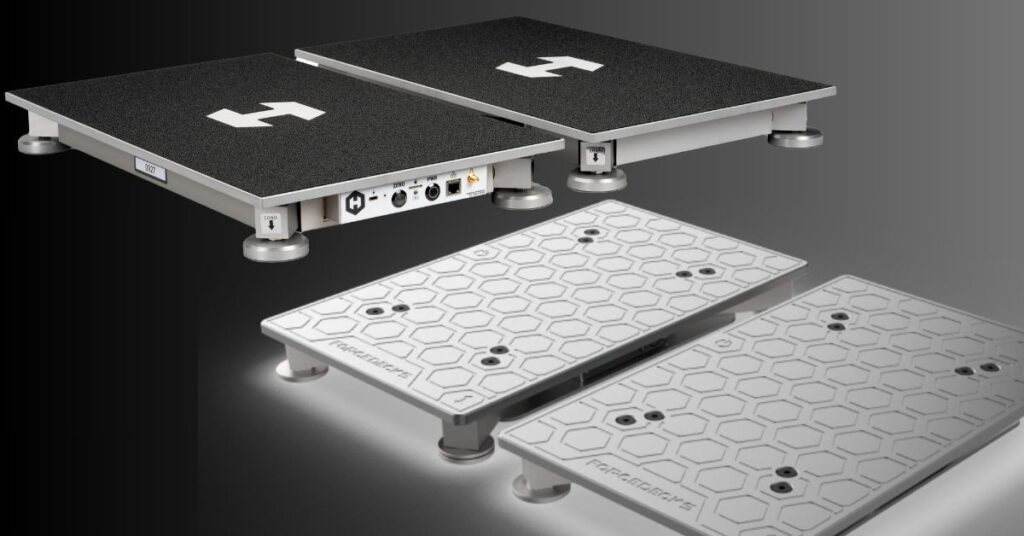
As sport evolves, the line between scientific research and applied coaching becomes thinner and more blurred. Several decades ago, PTs and performance professionals might read the research on force plates and then draw conclusions based on the results of a study. In the 2010s, some coaches were using force analysis with their athletes, but that was still a rarity. Now, high schools, smaller colleges, and small private facilities are capable of force analysis thanks to the increased accessibility of force plates and simplified software.
Throughout the years, rehab professionals and coaches have asked important questions as they strive to optimize athletic performance and decrease injury risk:
- Is my programming actually improving my athletes’ power?
- Are my athletes producing enough force and do they have sufficient symmetry to return to sport safely?
- Are my athletes getting fatigued from their practice, sport, or lift?
- Are my athletes developing strength and power over time?
- How can I answer these questions in the least time possible?
Force plates may aid coaches in answering these questions. In this Buyer’s Guide, the promise is direct: I’ll outline important considerations for making decisions on buying a set or multiple sets of force plates. I’ll also list the commonly advertised systems for coaches, and which are used more for research.
What Are Force Plates and Why the Rise in Popularity?
Force plates are force measuring platforms that help users answer questions about force production through varied movements and hundreds of different metrics.
Force plates have existed in labs and research settings for decades, but have become more popular due to companies developing user-friendly software, portable units, practical user-guides, and dropping the cost, says @MuyVienDPT. Share on X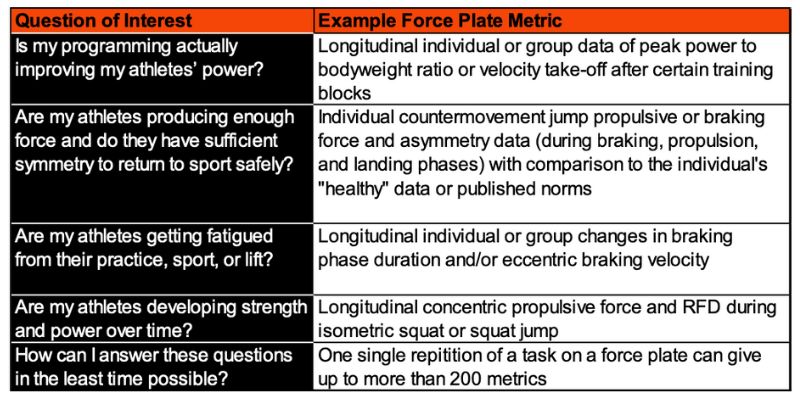
Force plates have existed in laboratories and research settings for decades, but have become more popular due to companies developing user-friendly software, portable units, practical user-guides, and dropping the cost over the years.
Contact mats and camera-based jump apps can give reliable jump height, ground contact time, and flight times; force plates, however, can give more versatile and accurate data.1,2 These metrics include force symmetry, center of pressures, displacements, magnitudes, velocities, and rate of development at different phases of the movements. Additionally, they can provide force data beyond just jumps. For example, they can give force metrics during squatting tasks, isometric tasks, and even measures relevant to balance such as center of pressure excursion and velocity of excursion (figure 2).

What Are the Standard Features?
In regards to hardware, all force plates are pretty similar in regards to load capacity, platform weight, Bluetooth, battery life, accuracy, and testing process. Essentially, the force plate provides information relative to the bodyweight of the person being tested. Because the forces are relative to bodyweight, all test sessions begin with a “weighing” or “quiet stand” phase where the system weighs the athlete alone or with load. A small sway of movement during these phases can produce large errors in the data due to magnification of the forces in calculating metrics of interest. Once users complete the weighting phase, the user then performs a pre-selected task, which gets measured by the load cell and converted to meaningful data (figure 3).
Where each company’s force plates differ are the nuances in their software during the testing portion as well as the reporting capabilities. For example, Kinvent and VALD have the athlete weigh once and then perform selected tests and reps, whereas Hawkin Dynamics requires a weighing period each rep. Another example of nuance is that VALD and Hawkin Dynamics allow for certain reps to be deleted if desired, whereas Kinvent only allows an entire session to be deleted. Regarding such deletions, Hawkin Dynamics and VALD allow the reps to be deleted during data collection, whereas Kinvent only allows session deletion after the testing session is completed; VALD does not allow for deletion of sessions unless you email their support or through the desktop-app. Luckily, all the softwares get updated frequently to reflect consumer preferences.

Despite all hardware being comparable, and the overall process from movement to data is the same, users should not compare the metrics between different companies. In 2022, Merrigan et al showed that there were differences in both force and power metrics between different companies.3 This is due to different algorithms that process the data to identify when a movement begins and ends, and also how the data and noise are filtered (figure 4). Lastly, some phases are labeled differently between companies; still, however, the reason for different data is still largely due to software filtering and algorithms (figure 5).
Despite the hardware being comparable, users should not compare the metrics between different companies—this is due to different algorithms that identify when a movement begins and ends and also how the data and noise are filtered. Share on X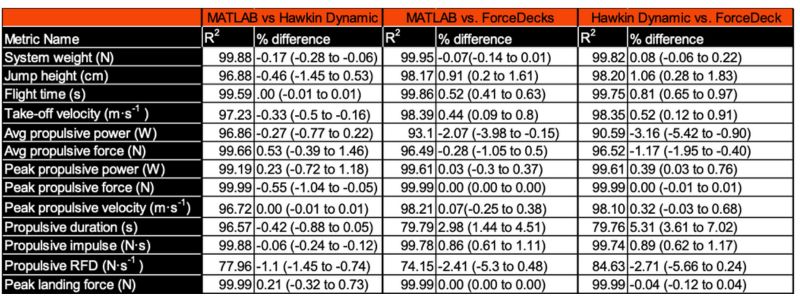
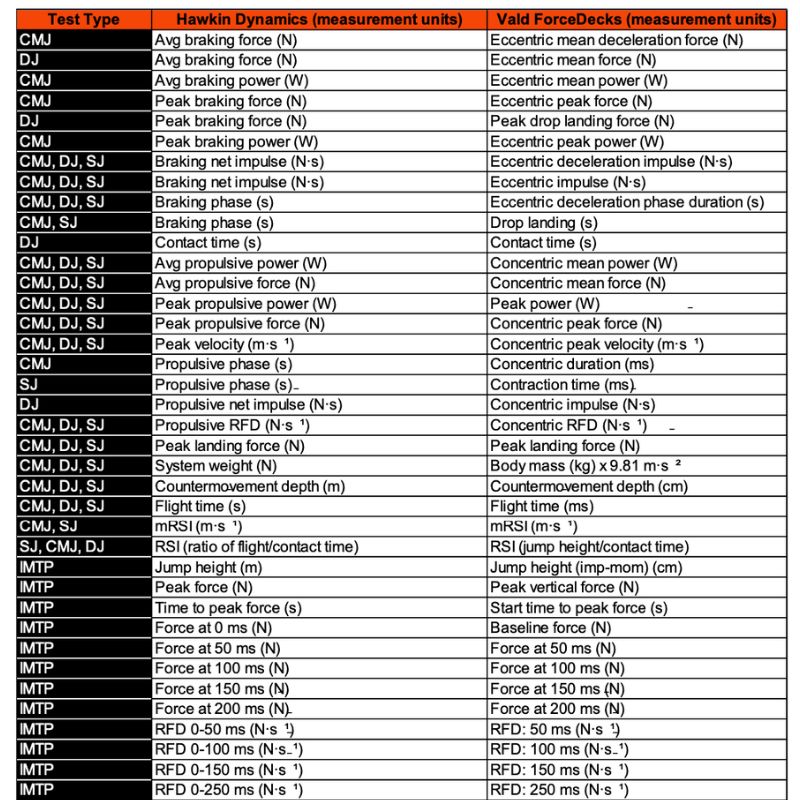
Who Are Force Plates For?
Performance specialists are starting to play a bigger role in team performance, and most of the buyers of force plates are strength coaches. As the idea of a High Performance team is becoming popular, the popularity of force plates has been trickling down to the rehab world to both better understand their peers and also discover new ways to utilize the data for rehab. Evidence supports the utility of force plate-derived metrics in multiple scenarios for performance and rehabilitation. Although jump height and reactive strength index can be collected from jump mats, force values may be more sensitive and have better utility in performance and rehab.
As the idea of a High Performance team is becoming popular, the popularity of force plates has been trickling down to the rehab world to both better understand their peers and also discover new ways to utilize the data for rehab. Share on XIn the past, research has reported that force plates were not useful in injury and physical performance prediction.4,5 However, these were single force plate platforms looking at specific movements and metrics. Due to the improved accessibility of dual force plate systems, ongoing research is being performed to challenge these views.6 Therefore, practitioners should be cautious in claims that force plates can predict physical performance and injury; however below are examples of how practitioners can apply current research to their practice.
Practical examples include:
- Tactical athletes: Counter-movement jump and loaded counter-movement jump metrics can be compared between individuals to see if there are individuals who may not perform “normal” under load. The load used may benefit from being standardized enough to reduce the variability of a jump, yet specific enough to mimic the weight and asymmetry of their occupational loads.7
- High school and college athletes: Specific concentric and eccentric metrics may be used to profile athletes to identify where they can develop. Additionally, position groups can be developed to better understand who may benefit from different programming. Phase duration metrics may also monitor fatigue to see if individuals have still not recovered from a game or practice. Practitioners should use descriptive statistics such as standard deviation or references norms to identify if changes are significant or just normal variance.8,9,10
- Rehab: Asymmetry metrics throughout different jump phases may be observed after injuries. Providers can determine if individuals’ motor plan of limb use is consistent with “normal” timelines, and if absolute concentric measures have returned to those similar to healthy controls. Practitioners should be aware of coefficient of variability of movements and phases of movements, as the traditional 10% asymmetry cut off may not be a valid threshold based on different error. 11,12
Every practitioner should know their limits as to how much sports science they can manage in their craft, as the added information they know may not help manage problems in front of them. A sports scientist is an advisor or a resource, and has to compromise their knowledge of biology to the constraints of team and Olympic sport, whereas researchers, data scientists, and biostatisticians have a higher level or understanding on data quality, methodology, and analysis. The integration between art and science is improving, and sport scientists should be encouraged to reach out to researchers to truly unlock their data. It is also imperative that an organization meet with all stakeholders to determine if the investment is worth it and to determine what existing problems force plates may solve (figure 6).
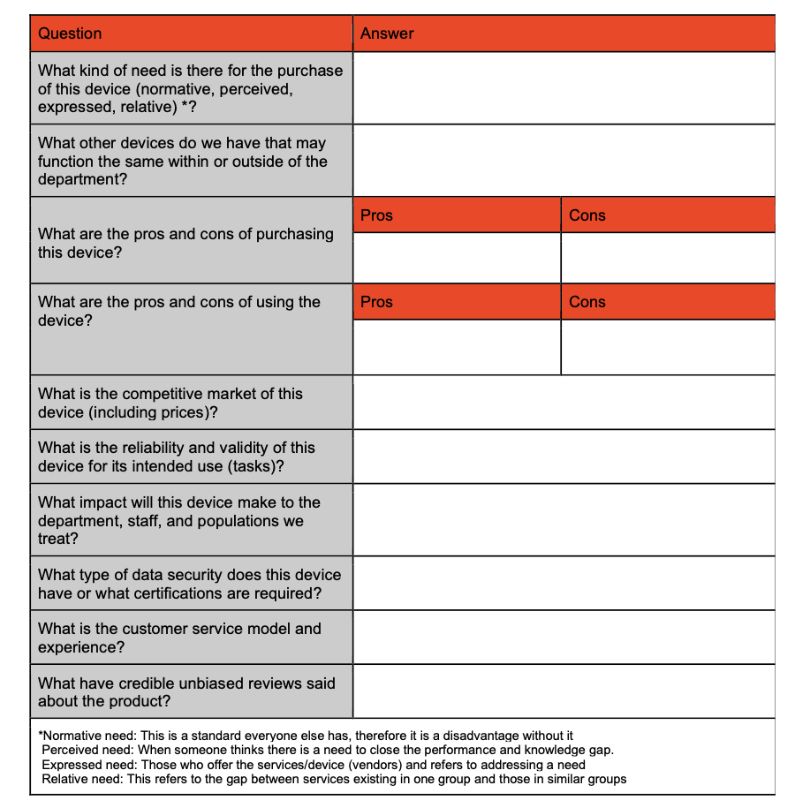
What Are the Top Brands in the Portable Force Plate Market?
Below are key points about different force plate experiences; however, I recommend you narrow our list, then reach out to a company’s support to determine if the user experience works best for your operations. The most popular brands are more thoroughly compared in figure 7.
Hawkin Dynamic – HD G5
Hawkin is an ideal brand for those who want to use force plates and who would like advanced analytics for individuals and teams, but who may be uncomfortable exporting the data to manipulate and analyze themselves. They boast highly-customized and beautiful reports, along with the ability to export data and customize data exports. Their software and hardware have been validated against gold standard measurements, and they will not access user data unless there is a needed cause and consent. Hawkin have leasing options as well as outright ownership. Their software can be integrated with other hardware, and they have API capability.
VALD – ForceDecks
VALD boasts an effective hub that integrates their other devices into a seamless ecosystem, and is ideal for those who need a suite of measurement devices in addition to just force plates. Their customer support is extensive, accessible, and constantly producing excellent content for easy application. The VALD hub offers quality reporting and analyses; however, most users export the raw data and perform their own analysis. Their export options are excellent and easy to use. VALD accesses customer data primarily to generate age, sex, and sport specific norms, but users ultimately own their data and such data can be deleted upon request. Their software can be integrated with other hardware, and they have API capability.
Kinvent – K-Deltas
Kinvent offers superior training tools such as feedback training as well as customized games and modes to train force deficits. Their software was built for physical therapists, and the clinical setting is where they shine. All traditional performance metrics are available, but not all are visualized as a default; can pick what metrics are shown as default. While the workflow and visualizations are excellent for one-on-one sessions, the team experience is not as fluid as other brands. All data can be exported; the export file, however, is not as ideal as other brands. They do not access user data, and users can delete it upon request. Kinvent have a vast array of devices that uniquely integrate with each other, and their app is easy to navigate. They boast the highest hardware capability of the portable force plates. Although such level of precision is not currently needed, they often innovate and find ways to use the powerful hardware. Their app does not work with other hardware, but they have API compatible with AMS softwares such as Smartabase.
Meloq – EasyBase
Meloq is a Swedish company with a customer focus largely on rehabilitation providers. At the time of publishing this Buyer’s Guide, they had just released their force plates. The app seemingly provides the same features as other apps, including specific testing modes, individual reports, and data that is exportable. The company’s earlier products, such as a goniometer and handheld dynamometer, do not integrate with the app, which can be a pro and a con—pro in that it does not need an app or external device to operate the other devices, but con in that reports are unable to integrate findings across multiple devices. Their plates are unique in that they are roughly 10lbs per plate, yet have the load capacity for jumps and isometric tests.
Bertec
Bertec Corporation, an Ohio company, is one of the leaders in research and gait analysis. They offer many serious tools and have specific force plates made for jumping and running (instrumented treadmill). Bertec is more known for their hardware, as they really do a good job making sure the equipment is durable and designed to stand up to the most rigorous testing environments.
Kistler
This Swiss company provides force and torque measurements for applications outside of sport, but their force plate grew in popularity when some teams adopted their hardware from a third-party vendor. While their system is top of the line, their price points are not for small teams or colleges with limited budgets. We recommend Kistler only for serious research and for human locomotion—like cutting and running—but not for general jump analysis. The software available for Kistler is not known to be very coach-friendly, but when you invest in Kistler, you are mainly looking for hardware.
PASCO Scientific
PASCO options are inexpensive and several training organizations have them; however, you must know how to do some programming, leverage GitHub files, or have external software to calculate measurements outside of raw force changes. When purchasing PASCO products, be sure to double check-load capacities that can handle movements from your team.
AMTI
AMTI, located in Massachusetts, is a very industrial-driven company and committed to the general needs of human force and ergonomics—not just sport. Like Bertec, AMTI is a large company and has a history of working with international federations and researchers. The company’s strength is the hardware, and they are often the reference standard for others attempting to validate their hardware. Several professional teams use this force plate brand, but AMTI seems at a crossroads with providing products for institutions and sports medicine rather than directly for coaches.
Contemplas
The system from this German company is dry, but straightforward, and it simply performs well. Contemplas provides both hardware and as well as excellent software. One feature of their software is that it can be used with other force plates outside of its own ecosystem, and this is very useful because most native software options are done with limited budgets. The force plates are very thick, and while they are technically portable, they are better for moving easily between facilities than for airline travel.
CC Athletics – ForceMate
CC Athletics is a company based in Denmark that make an array of sensors. For their force plates, CC Athletics currently require no subscription. That absence of a subscription comes with trade-offs, such as fewer testing activities, fewer available metrics, laptop compatibility only (force plate must be wired with USB), and a wifi connection must be available. Most users may do fine with their force plates given those trade-offs. Their single software runs all their other sensors as well, and users can quickly switch between the sensors during testing. The data can be exported; however, they currently do not have API capability. They have validated their jump height against MyJump app, and are currently in the process of validating them against the AMTI force plates.
A few white-label products or added value companies exist, but are not listed here to avoid information overflow. Some smaller players are also not included because they may be lacking base hardware and software validity and reliability information.

Final Considerations
I can predict that force plates will remain a mainstay in performance and rehab. Computer vision, wearable sensors, and barbell options can provide valuable insights, but coaches love the simplicity of a physical system that can get to the heart of what an athlete can do: produce large forces quickly into the ground. Across the board, hardware is sufficient and largely the same; the customer service and software capabilities, however, are the differentiators. Because the software is the highlight of force plates, users should feel confident in subscription-based pricing since their experience will improve largely due to the arms race in software updates.
Because the software is the highlight of force plates, users should feel confident in subscription-based pricing since their experience will improve largely due to the arms race in software updates, says @MuyVienDPT. Share on XUltimately, you can spend months calling and visiting coaches to see what is right for you, but the reality is that it’s only a good idea to buy force plates if you know your own operations and specific questions you would want to answer. Many people collect data for the sake of collecting data and staying “cutting-edge,”but the investment will only be worth it if you are willing to act on the data. Force plates are great for force management in training, not passive sideline observation of practices. In my opinion, both sports medicine and sports performance professionals should include force analysis as a metric for keeping athletes healthy or getting them back into health.
Since you’re here…
…we have a small favor to ask. More people are reading SimpliFaster than ever, and each week we bring you compelling content from coaches, sport scientists, and physiotherapists who are devoted to building better athletes. Please take a moment to share the articles on social media, engage the authors with questions and comments below, and link to articles when appropriate if you have a blog or participate on forums of related topics. — SF
References
1. Buckthorpe M, Morris J, Folland JP. Validity of vertical jump measurement devices. J Sports Sci. 2012;30(1):63-9. doi: 10.1080/02640414.2011.624539. Epub 2011 Nov 23. PMID: 22111944.
2. Lake J, Mundy P, Comfort P, McMahon JJ, Suchomel TJ, Carden P. Concurrent Validity of a Portable Force Plate Using Vertical Jump Force-Time Characteristics. J Appl Biomech. 2018 Oct 1;34(5):410-413. doi: 10.1123/jab.2017-0371. Epub 2018 Oct 11. PMID: 29809100.
3. Merrigan JJ, Stone JD, Galster SM, Hagen JA. Analyzing Force-Time Curves: Comparison of Commercially Available Automated Software and Custom MATLAB Analyses. J Strength Cond Res. 2022 Sep 1;36(9):2387-2402. doi: 10.1519/JSC.0000000000004275. Epub 2022 Jun 24. PMID: 35916879.
4. Scott WC, Hando BR, Butler CR, Mata JD, Bryant JF, Angadi SS. Force plate vertical jump scans are not a valid proxy for physical fitness in US special warfare trainees. Front Physiol. 2022 Nov 16;13:966970. doi: 10.3389/fphys.2022.966970. PMID: 36467678; PMCID: PMC9709481.
5. Hando BR, Scott WC, Bryant JF, Tchandja JN, Angadi SS. The Use of Force Plate Vertical Jump Scans to Identify Special Warfare Trainees at Risk for Musculoskeletal Injury: A Large Cohort Study. Am J Sports Med. 2022 May;50(6):1687-1694. doi: 10.1177/03635465221083672. Epub 2022 Apr 6. PMID: 35384740.
6. Bishop, Chris & Jordan, Matthew & Torres-Ronda, Lorena & Loturco, Irineu & Harry, John & Virgile, Adam & Mundy, Peter & Turner, Anthony & Comfort, Paul. (2022). Selecting Metrics That Matter: Comparing the Use of the Countermovement Jump for Performance Profiling, Neuromuscular Fatigue Monitoring, and Injury Rehabilitation Testing. Strength and Conditioning Journal. Publish Ahead of Print. 10.1519/SSC.0000000000000772.
7. Merrigan JJ, Stone JD, Martin JR, Hornsby WG, Galster SM, Hagen JA. Applying Force Plate Technology to Inform Human Performance Programming in Tactical Populations. Applied Sciences. 2021; 11(14):6538. https://doi.org/10.3390/app11146538
8. Cabarkapa D, Philipp NM, Cabarkapa DV, Fry AC. Position-specific differences in countermovement vertical jump force-time metrics in professional male basketball players. Front Sports Act Living. 2023 Jul 20;5:1218234. doi: 10.3389/fspor.2023.1218234. PMID: 37547821; PMCID: PMC10398786.
9. Philipp NM, Cabarkapa D, Nijem RM, Fry AC. Changes in countermovement jump force-time characteristic in elite male basketball players: A season-long analyses. PLoS One. 2023 Sep 27;18(9):e0286581. doi: 10.1371/journal.pone.0286581. PMID: 37756277; PMCID: PMC10529540.
10. Cabarkapa D, Cabarkapa DV, Philipp NM, Knezevic OM, Mirkov DM, Fry AC. Pre-Post Practice Changes in Countermovement Vertical Jump Force-Time Metrics in Professional Male Basketball Players. J Strength Cond Res. 2023 Nov 1;37(11):e609-e612. doi: 10.1519/JSC.0000000000004608. PMID: 37883409.
11. Kotsifaki R, Sideris V, King E, Bahr R, Whiteley R. Performance and symmetry measures during vertical jump testing at return to sport after ACL reconstruction. Br J Sports Med. 2023 Oct;57(20):1304-1310. doi: 10.1136/bjsports-2022-106588. Epub 2023 Jun 1. PMID: 37263763.
12. Read PJ, Michael Auliffe S, Wilson MG, Graham-Smith P. Lower Limb Kinetic Asymmetries in Professional Soccer Players With and Without Anterior Cruciate Ligament Reconstruction: Nine Months Is Not Enough Time to Restore “Functional” Symmetry or Return to Performance. Am J Sports Med. 2020 May;48(6):1365-1373. doi: 10.1177/0363546520912218. Epub 2020 Apr 15. PMID: 32293904.
